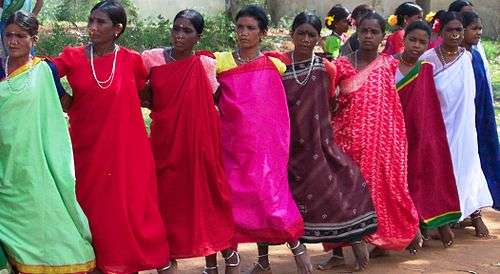Dhimsa

Dhimsa, a tribal dance form, is performed by the Porja caste women. A group of 15-20 women form a circle and dance praising the deity for the welfare of their domestic life. They also dance at the weddings since the women pray for peaceful and happy married life. They typically wear tribal dresses and ornaments while the leading lady also carries a peacock feather in her hand.
Origin
The dance is originated in Koraput district in Odisha but has almost become an official dance of Visakhapatnam. Dhimsa is in the groove with the culture of this region, especially with places near Araku and Borra Caves, the famous tourist destinations in the region.
Style of Dance
This expressive dance is dominated by the movements of feet and hands of the group performing the dance in a circle. Though this dance can be performed by men and women, young and old, typically around 15-20 women form a chain and move their feet according to the rhythm and make formations of smaller to larger circles. There are several variations in this dance. The popular twelve variations are: 1. Bag Dhimisa 2. Natikari Dhimsa 3. Kunda Dhimisa 4. Pathartola Dhimisa 5. Pedda Dhimisa 6. Sambor Nisani Dhimisa 7. Bayya Dhimisa 8. Mouli Dhimisa 8.Choti Dhimisa 9. Boda Dhimsa ( Involves worship of their ritual goodness or god in villages.) 10. Goddi Beta Dimsa (Dancer moves both backward and forward with the swinging of body.)
Instruments
The members play Dappu (drum with a short stick), Tudumu, Mori, Kiridi and Jodukommulu. The performers dance to the drum beats and usually the music is played by men.
Costume
The attire is colorful with earthy tones of green, red and yellow. They wear sarees that fall just below the knee. Their necks are adorned with tribal ornaments.
References
- http://www.visitvizag.in/dhimsa.asp
- http://www.discoveredindia.com/andhra-pradesh/culture-in-andhra-pradesh/dance-in-andhra-pradesh/dhimsa.htm
- http://www.thehindu.com/todays-paper/tp-national/tp-otherstates/dhimsa-dance-festival-inaugurated/article1204702.ece
- http://www.indiantravelportal.com/andhra-pradesh/dances/dhimsa.html